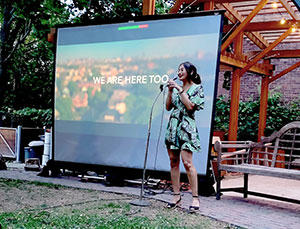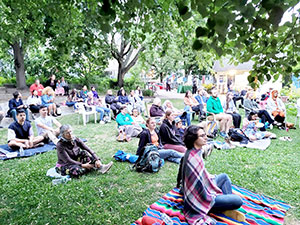
Somerville artist Iaritza Menjivar addressed the spectators gathered at the premiere of the new documentary “We Are Here Too.” — Photos by Emiliano Calvo
By Maeve Lawler
The documentary We Are Here Too premiered on Thursday, June 16. Spectators gathered at the Somerville Community Growing Center to learn about the stories of four women of color living in Somerville and their experiences as artists during the COVID-19 pandemic.
Keidrick Roy, Lili Bayarmagnai, and Julia Reihs produced the 23-minute film that featured four artists: Iaritza Menjivar, Tori Weston, Raynel Shepard, and Sneha Shrestha (Imagine).
We Are Here Too walks the audience through each woman’s artistic journey while focusing on how they used their art to navigate the pandemic, coupled with social justice uprisings in 2020.
In the documentary, Menjivar discussed how her work as a photographer connects to her family. She said in the documentary, “I like to take pictures because through pictures I have found my own voice – in this world, in our family.”
Menjivar, whose parents immigrated from Guatemala, also talked about the importance of depicting immigrant success stories.
“When we refer to successful immigrant stories, we talk about the immigrants who are working the most prestigious jobs in the United States and have the most prestigious education,” she said in the documentary. “An immigrant success story doesn’t always have to be about that.”
 Weston, a lithographer and writer, shared in an interview with the Somerville Times that her art piece titled Two Definitions of a Black Woman inspired her to combine her lithography and writing skills. During the pandemic, she made various portraits of Black and brown women, which are featured in the documentary.
Weston, a lithographer and writer, shared in an interview with the Somerville Times that her art piece titled Two Definitions of a Black Woman inspired her to combine her lithography and writing skills. During the pandemic, she made various portraits of Black and brown women, which are featured in the documentary.
“There are things that society put on Black women and Black women’s bodies, but then Black women are always in a position to hype themselves up. We have to look at ourselves and know that we are amazing people,” Weston said.
In the documentary, Shepard, a jazz singer, discussed her Creole heritage, as well her experiences during the Civil Rights Movement in comparison with the Black Lives Matter movement.
About the Civil Rights Movement and Martin Luther King Jr’s assassination, Shepard said in the documentary, “It was really frightening to be part of a generation that was really trying to help change things and just see it destroyed in front of you because it’s all televised.”
Sneha Shrestha (Imagine) is a graffiti artist whose work often features Napili lettering. Imagine has spent most of her life in Nepal and said that her work is the best way “to represent my culture in the most real way,” she said in the documentary.
During the pandemic, Imagine created prints to raise funds for Stop Asian Hate, which sold out within 24 hours.
In an interview with The Somerville Times, Weston spoke about her experience as a Black woman during the pandemic, which We Are Here Too also highlights.
“It’s been very stressful. I think the pandemic really pulls back layers of what has already been racial tensions in our country, but I think it really showed like ‘oh wow, these things still exist,’” she said.
Weston said that she has to navigate issues like, “Am I safe in Somerville? When I walk outside of my house, what is going to happen?” She added, “And how can I be, not necessarily okay, but coexist in knowing that I think this is fabulous and beautiful and everything but enter a world every day that opposes that?”
Concerning her art during the pandemic, Weston said she had to face many of her anxieties and emotions. “I feel like in some ways the pandemic has made, at least my work, a lot more honest and confronting of my own personal anxieties, but also being able to see well ‘how to do I fit in a larger context,’” Weston said.
Weston also discussed how We Are Here Too sheds light on artists of color in Somerville.
“I think the documentary gives people a snippet of ‘We exist in this city. We’re here. But we’re also trying to document what it’s like to live in a city praised for being an amazing artistic community but you still feel like an outsider,’” Weston said.
She hopes the documentary will result in two things: getting the community interested in seeking out artists of color and using art to spark a conversation commenting on human experiences.
Weston said, “The pandemic was sort of the tip of the iceberg of how we can take something that is devastating and use art as a way to talk about our feelings. Use art as a way to get people to rethink how we see things.”
To learn more about the artists and We Are Here Too, visit here.













Reader Comments